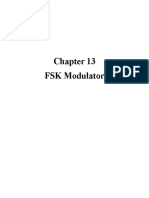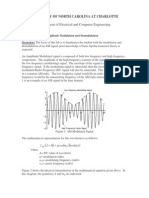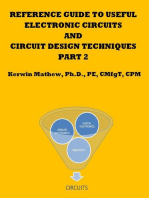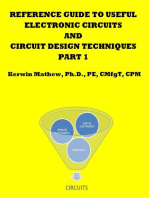Experiment 3 Frequency Modulator: 1 Theory
Experiment 3 Frequency Modulator: 1 Theory
Uploaded by
reganoctCopyright:
Available Formats
Experiment 3 Frequency Modulator: 1 Theory
Experiment 3 Frequency Modulator: 1 Theory
Uploaded by
reganoctOriginal Description:
Original Title
Copyright
Available Formats
Share this document
Did you find this document useful?
Is this content inappropriate?
Copyright:
Available Formats
Experiment 3 Frequency Modulator: 1 Theory
Experiment 3 Frequency Modulator: 1 Theory
Uploaded by
reganoctCopyright:
Available Formats
EED3014 Analog Electronics- 2013 Spring
Experiment 3
Group No
Grade
Student number
and name
Student number
and name
Student number
and name
Experiment 3
Frequency Modulator
Preliminary Work
1. Obtain the datasheet of LM565 PLL integrated circuit. Groups without datasheet will
get less credit.
2. No other preliminary work will be submitted for this laboratory.
ATTENTION
Each group will submit only one report which will be completed on this experiment
document.
THEORY
In amplitude modulation, the amplitude of the carrier is modulated by a message signal, hence
the amplitude variations of the message signal directly changes the modulated wave. Since
noise is modelled as additive noise, this property of AM becomes a disadvantage. However, in
frequency modulation, the information signal is impressed on the carrier signal frequency.
FM generation is relatively easy. A linear voltage-to-frequency is needed in order to obtain
FM signal. This can be achieved using a voltage controlled oscillator. In this experiment LM565
PLL integrated circuits internal VCO will be used. In Fig. 1, a frequency modulator circuit
can be seen. The frequency of the VCO output of LM565 is given as:
f=
2.4(Vcc Vc )
Rt Ct Vcc
(1)
where Rt is the timing resistance on pin 8, Ct is the timing capacitance on pin 9,V (cc) is the
power supply voltage and V (c) is the control voltage on pin 7.
When the datasheet of LM565 is examined, it is observed that the voltage of pin 7 must be
between 4 and 5 V. Thus the information signal must have a DC offset. The capacitor C3 and
resistor R3 , which constitute a DC block, control pin 7 voltage. Observing the Eq. 1, the VCO
frequency decreases as DC voltage rises and increases as DC voltage falls.
Considerable amount of RF signal from VCO may leak out of pin 7 of LM565. Components
R6 and C4 form a low-pass filter to prevent this RF energy from passing back to the audio
input.
1
EED3014 Analog Electronics- 2013 Spring
Experiment 3
Figure 1: Frequency modulator employing LM565
Vaverage
LM565 Pin 7
voltage
Modulator Sensitivity
The modulator sensitivity of frequency with respect to the control voltage can be found by differentiating the Eq. 1 with respect to control voltage Vc where Vc = vm (t) + DC control voltage.
K0 =
2.4
dF
=
(Hz/V)
dVc
Rt Ct Vcc
(2)
The minus sign indicates that positive message voltage decreases VCO frequency.
Frequency Deviation
The amount of frequency deviation produced by VCO is proportional to the amplitude of the
message signal. The amount of deviation can be predicted using the following equation.
= Vm K0 Hz
(3)
where K0 is the modulator sensitivity in Hz/Volt, Vm is the peak value of message signal and
is the deviation or peak frequency swing.
PROCEDURE
a. Build the circuit in Fig. 1. Do not connect anything to the AF INPUT yet.
2
EED3014 Analog Electronics- 2013 Spring
Experiment 3
b. Connect the FM output of the circuit to the oscilloscope. Adjust R3 until a 100kHz carrier
wave is obtained. The shape of output of VCO must be a square wave.
c. Calculate K0 , the modulator sensitivity using Eq. 2(Show all necessary calculation steps.)
K0 (calculated)=
d. Now connect a signal generator to the AF INPUT. Adjust it for 5kHz frequency, and
correct peak voltage for 10 kHz deviation. (Use the result from step c). Calculate and
note the peak value below.(Show all necessary calculation steps.)
vpeak =
e. Connect scope channel 1 to the AF INPUT, and scope channel 2 to the FM OUTPUT.
Record the graph below. Do not forget to indicate the important points like peak voltage
and period on the figure. Can you see the frequency deviation?
EED3014 Analog Electronics- 2013 Spring
Experiment 3
Volt/div=
time/div=
Figure 2: AF Input versus FM Output
EED3014 Analog Electronics- 2013 Spring
3
3.1
Experiment 3
Conclusion
Student Name and ID:
EED3014 Analog Electronics- 2013 Spring
3.2
Experiment 3
Student Name and ID:
EED3014 Analog Electronics- 2013 Spring
3.3
Experiment 3
Student Name and ID:
You might also like
- A Guide to Electronic Maintenance and RepairsFrom EverandA Guide to Electronic Maintenance and RepairsRating: 4.5 out of 5 stars4.5/5 (7)
- Experiment 2 PWM Modulators: Educational ObjectivesDocument12 pagesExperiment 2 PWM Modulators: Educational Objectivesnainesh goteNo ratings yet
- FM Modulators: Experiment 7Document17 pagesFM Modulators: Experiment 7banduat83No ratings yet
- Ecgr3156 Experiment 8 Amplitude Modulation and DemodulationDocument7 pagesEcgr3156 Experiment 8 Amplitude Modulation and Demodulationelsadiqm7No ratings yet
- FSKDocument10 pagesFSKJyotirmoy Deka100% (1)
- Eng Mohammed K Abu Foul Experiment 8 FSKDocument10 pagesEng Mohammed K Abu Foul Experiment 8 FSKHassan SalemNo ratings yet
- Communication Lab Manual EL394 PDFDocument26 pagesCommunication Lab Manual EL394 PDFKhan Shahrukh AshrafNo ratings yet
- Ec2405 Optical and Microwave Ece Lab ManualDocument26 pagesEc2405 Optical and Microwave Ece Lab ManualVasu Manikandan100% (2)
- Pulse Amplitude Modulation and Demodulation - Google SearchDocument30 pagesPulse Amplitude Modulation and Demodulation - Google SearchHasan SkNo ratings yet
- EE680Lab Experiment6-7Document21 pagesEE680Lab Experiment6-7Amro AbusailNo ratings yet
- Sampling Theorem Verification: Electronics & Communication EngineeringDocument0 pagesSampling Theorem Verification: Electronics & Communication Engineeringagama1188No ratings yet
- Ec 4112: Analog Communication Laboratory List of Experiments: Compulsory ExperimentsDocument68 pagesEc 4112: Analog Communication Laboratory List of Experiments: Compulsory ExperimentsArchit SrivastavaNo ratings yet
- Practical 1.1: Initial Setting-Up and Measurement of Transmission PowerDocument9 pagesPractical 1.1: Initial Setting-Up and Measurement of Transmission PowerKing MalikNo ratings yet
- EE2003-E03 Operational AmplifierDocument6 pagesEE2003-E03 Operational AmplifierntldvlaiNo ratings yet
- EC 351 AC Analog Communication Lab ManualDocument117 pagesEC 351 AC Analog Communication Lab Manualhodibaaba1No ratings yet
- Nollido Acee6l Exp6 Ee2hDocument10 pagesNollido Acee6l Exp6 Ee2hrusselpagaoNo ratings yet
- AskDocument8 pagesAskchiko12345100% (1)
- 3ECE-AC Lab ManualDocument62 pages3ECE-AC Lab ManualShannon DunnNo ratings yet
- Lab ManualDocument38 pagesLab ManualsruharithaNo ratings yet
- Mamaradlo ErikaMae 2B Expt1Document6 pagesMamaradlo ErikaMae 2B Expt1Erika Mae MamaradloNo ratings yet
- Mamaradlo ErikaMae 2B Expt2 FinalDocument10 pagesMamaradlo ErikaMae 2B Expt2 FinalErika Mae MamaradloNo ratings yet
- Chapter 13 FSK ModDocument22 pagesChapter 13 FSK ModberkahNo ratings yet
- Frequency Modulation and Demodulation Using Optical LinkDocument11 pagesFrequency Modulation and Demodulation Using Optical LinkPriyansh RupaniNo ratings yet
- OC Expt05 60002200083Document14 pagesOC Expt05 60002200083Raj mehtaNo ratings yet
- Communication LabDocument34 pagesCommunication LabSingam DonNo ratings yet
- Chapter 11 ASK ModDocument21 pagesChapter 11 ASK ModAndiWahyuNo ratings yet
- Communication Systems Lab ManualDocument74 pagesCommunication Systems Lab ManualHailin Arumiga100% (1)
- Analog Communications Lab ManualDocument61 pagesAnalog Communications Lab ManualSriLakshmi RaheemNo ratings yet
- Analog Assignment FinalprintDocument20 pagesAnalog Assignment FinalprintAshish KumarNo ratings yet
- FM Demodulation PDFDocument13 pagesFM Demodulation PDFashwini100% (1)
- 8 ModulationDocument8 pages8 ModulationAhmadAkhbariNo ratings yet
- Implementation of Frequency Demodulator Using The PLL Demodulation MethodDocument4 pagesImplementation of Frequency Demodulator Using The PLL Demodulation MethodasmonovNo ratings yet
- Lab - 1 Amplitude Modulation and Demodulation: 1.1 ObjectiveDocument13 pagesLab - 1 Amplitude Modulation and Demodulation: 1.1 Objectivetendua_13No ratings yet
- Introduction To The Industry:-: Chapter - 1Document35 pagesIntroduction To The Industry:-: Chapter - 1Pratik VasagadekarNo ratings yet
- Digital Control of A Three Phase 4 Wire PWM Inverter For PVDocument9 pagesDigital Control of A Three Phase 4 Wire PWM Inverter For PV7788778887No ratings yet
- Lab1 AM Modulation Demod HandoutDocument5 pagesLab1 AM Modulation Demod HandoutAshok Naik100% (1)
- Experiment No 1 AM TransmitterDocument6 pagesExperiment No 1 AM TransmitterashfaqiNo ratings yet
- III/IV B.Tech (ECE) Sixth Semester: Ec361 - Digital Communication LabDocument66 pagesIII/IV B.Tech (ECE) Sixth Semester: Ec361 - Digital Communication LabBalu HanumanthuNo ratings yet
- r13 Ica Lab 2015 ManualDocument53 pagesr13 Ica Lab 2015 ManualEce Nellore100% (1)
- Practicas Digiac 1750 1Document18 pagesPracticas Digiac 1750 1Saga Adolfo GonzalezNo ratings yet
- Lab ManualDocument50 pagesLab ManualGayathriRajiNo ratings yet
- Low Power High Speed I/O Interfaces in 0.18um CmosDocument4 pagesLow Power High Speed I/O Interfaces in 0.18um Cmosayou_smartNo ratings yet
- Lab ManualDocument56 pagesLab ManualNarendra ReddyNo ratings yet
- Analog CommunicationDocument48 pagesAnalog CommunicationBrzata Ptica100% (1)
- Transformer Coupled AmplifierDocument6 pagesTransformer Coupled AmplifierXyrex CalangNo ratings yet
- 3ece Ac Lab Manual 2 11Document109 pages3ece Ac Lab Manual 2 11Malladi Sreedevi RajithaNo ratings yet
- EEE Lab3Document43 pagesEEE Lab3Sanjid ElahiNo ratings yet
- PT3 - 13 - FSK Modulator PDFDocument20 pagesPT3 - 13 - FSK Modulator PDFTempa100% (1)
- Sdic II NotesDocument28 pagesSdic II NotesPAVETHRA R SNo ratings yet
- Reference Guide To Useful Electronic Circuits And Circuit Design Techniques - Part 2From EverandReference Guide To Useful Electronic Circuits And Circuit Design Techniques - Part 2No ratings yet
- Reference Guide To Useful Electronic Circuits And Circuit Design Techniques - Part 1From EverandReference Guide To Useful Electronic Circuits And Circuit Design Techniques - Part 1Rating: 2.5 out of 5 stars2.5/5 (3)
- Analysis and Design of Multicell DC/DC Converters Using Vectorized ModelsFrom EverandAnalysis and Design of Multicell DC/DC Converters Using Vectorized ModelsNo ratings yet
- Exercises in Electronics: Operational Amplifier CircuitsFrom EverandExercises in Electronics: Operational Amplifier CircuitsRating: 3 out of 5 stars3/5 (1)
- Analog Dialogue, Volume 48, Number 1: Analog Dialogue, #13From EverandAnalog Dialogue, Volume 48, Number 1: Analog Dialogue, #13Rating: 4 out of 5 stars4/5 (1)
- WWW - Manaresults.Co - In: (Common To Ece, Etm)Document2 pagesWWW - Manaresults.Co - In: (Common To Ece, Etm)reganoctNo ratings yet
- 114 DN 052015Document2 pages114 DN 052015reganoctNo ratings yet
- 8257 Programmable Dma ControllerDocument4 pages8257 Programmable Dma ControllerreganoctNo ratings yet
- Changes: Anna University, ChennaiDocument3 pagesChanges: Anna University, ChennaireganoctNo ratings yet
- Addition Ug Am 17Document3 pagesAddition Ug Am 17reganoctNo ratings yet
- 8257 Programmable Dma ControllerDocument4 pages8257 Programmable Dma ControllerreganoctNo ratings yet
































































